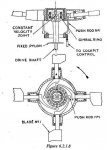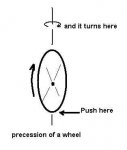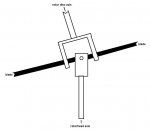birdy
Active Member
- Joined
- Mar 19, 2004
- Messages
- 7,066
- Location
- Alice Springs-central Oz.
- Aircraft
- open frame single seat & a 'wasa' RAF, among other types.
- Total Flight Time
- 7000 odd, bout 5000 gyro
but I have never delved this deeply into it.
I never woulda even bothered either Leigh, but thats the way the thread has headed, so im follown along.
Mind you, the end result aint worth 2 knobs of nanny goat cr@p in real life, wotever the result is, but iv started now, and my curiosity wont let me stop.
[ how would we be without the likes of Mr. Beaty?]
No dout he'll have an instant answer thatll shoot me down ina fire ball.
Birdy, I think the effect is not doubled. It was canceled.
JC, id imagin youd have as much trouble understandn me as i you, so you have my simpathys.
But, with wot im on about, youv gota ditinguish and seperate between the internal inertia of the disc, external inertia of the disc, lift, drag and the effects of gravity, coz they are all pulln different ways, while at the same time, balanced.
energy to mount the blade is provided by the blade that descends. And it produces a bending bar hub in the vertical plane.
Im assuming you mean move, where youv got mount.
If the lifting blade was lifted through the axis of the teeter bolt by the decending opposit blade, your hub bar wouldnt last 5 seconds. They EQUALY compensate for differing airspeds at the same time, so the seesaw is powered airodynamicaly, not each blade leavering the other.
I never woulda even bothered either Leigh, but thats the way the thread has headed, so im follown along.
Mind you, the end result aint worth 2 knobs of nanny goat cr@p in real life, wotever the result is, but iv started now, and my curiosity wont let me stop.
[ how would we be without the likes of Mr. Beaty?]
No dout he'll have an instant answer thatll shoot me down ina fire ball.
Birdy, I think the effect is not doubled. It was canceled.
JC, id imagin youd have as much trouble understandn me as i you, so you have my simpathys.
But, with wot im on about, youv gota ditinguish and seperate between the internal inertia of the disc, external inertia of the disc, lift, drag and the effects of gravity, coz they are all pulln different ways, while at the same time, balanced.
energy to mount the blade is provided by the blade that descends. And it produces a bending bar hub in the vertical plane.
Im assuming you mean move, where youv got mount.
If the lifting blade was lifted through the axis of the teeter bolt by the decending opposit blade, your hub bar wouldnt last 5 seconds. They EQUALY compensate for differing airspeds at the same time, so the seesaw is powered airodynamicaly, not each blade leavering the other.




